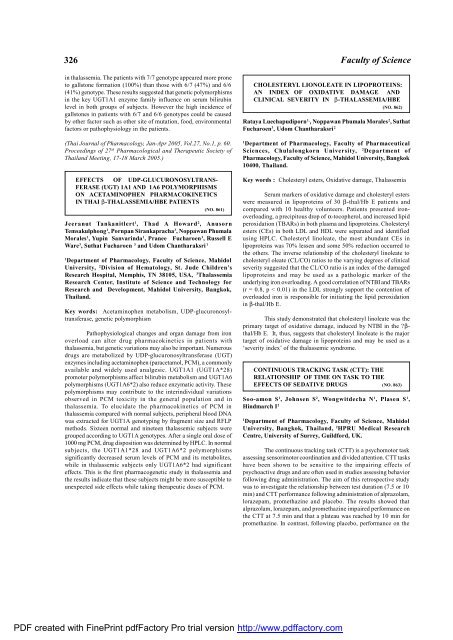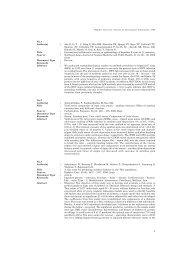Faculty of Science - Mahidol University
Faculty of Science - Mahidol University
Faculty of Science - Mahidol University
You also want an ePaper? Increase the reach of your titles
YUMPU automatically turns print PDFs into web optimized ePapers that Google loves.
326<br />
in thalassemia. The patients with 7/7 genotype appeared more prone<br />
to gallstone formation (100%) than those with 6/7 (47%) and 6/6<br />
(41%) genotype. These results suggested that genetic polymorphisms<br />
in the key UGT1A1 enzyme family influence on serum bilirubin<br />
level in both groups <strong>of</strong> subjects. However the high incidence <strong>of</strong><br />
gallstones in patients with 6/7 and 6/6 genotypes could be caused<br />
by other factor such as other site <strong>of</strong> mutation, food, environmental<br />
factors or pathophysiology in the patients.<br />
(Thai Journal <strong>of</strong> Pharmacology, Jan-Apr 2005, Vol.27, No.1, p. 60.<br />
Proceedings <strong>of</strong> 27 th Pharmacological and Therapeutic Society <strong>of</strong><br />
Thailand Meeting, 17-18 March 2005.)<br />
EFFECTS OF UDP-GLUCURONOSYLTRANS-<br />
FERASE (UGT) 1A1 AND 1A6 POLYMORPHISMS<br />
ON ACETAMINOPHEN PHARMACOKINETICS<br />
IN THAI b-THALASSEMIA/HBE PATIENTS<br />
(NO. 861)<br />
Jeeranut Tankanitlert 1 , Thad A Howard 2 , Anusorn<br />
Temsakulphong 1 , Pornpan Sirankapracha 3 , Noppawan Phumala<br />
Morales 1 , Yupin Sanvarinda 1 , Pranee Fucharoen 3 , Russell E<br />
Ware 3 , Suthat Fucharoen 3 and Udom Chantharaksri 1<br />
1 Department <strong>of</strong> Pharmacology, <strong>Faculty</strong> <strong>of</strong> <strong>Science</strong>, <strong>Mahidol</strong><br />
<strong>University</strong>, 2 Division <strong>of</strong> Hematology, St. Jude Children’s<br />
Research Hospital, Memphis, TN 38105, USA, 3 Thalassemia<br />
Research Center, Institute <strong>of</strong> <strong>Science</strong> and Technology for<br />
Research and Development, <strong>Mahidol</strong> <strong>University</strong>, Bangkok,<br />
Thailand.<br />
Key words: Acetaminophen metabolism, UDP-glucuronosyltransferase,<br />
genetic polymorphism<br />
Pathophysiological changes and organ damage from iron<br />
overload can alter drug pharmacokinetics in patients with<br />
thalassemia, but genetic variations may also be important. Numerous<br />
drugs are metabolized by UDP-glucuronosyltransferase (UGT)<br />
enzymes including acetaminophen (paracetamol, PCM), a commonly<br />
available and widely used analgesic. UGT1A1 (UGT1A*28)<br />
promoter polymorphisms affect bilirubin metabolism and UGT1A6<br />
polymorphisms (UGT1A6*2) also reduce enzymatic activity. These<br />
polymorphisms may contribute to the interindividual variations<br />
observed in PCM toxicity in the general population and in<br />
thalassemia. To elucidate the pharmacokinetics <strong>of</strong> PCM in<br />
thalassemia compared with normal subjects, peripheral blood DNA<br />
was extracted for UGT1A genotyping by fragment size and RFLP<br />
methods. Sixteen normal and nineteen thalassemic subjects were<br />
grouped according to UGT1A genotypes. After a single oral dose <strong>of</strong><br />
1000 mg PCM, drug disposition was determined by HPLC. In normal<br />
subjects, the UGT1A1*28 and UGT1A6*2 polymorphisms<br />
significantly decreased serum levels <strong>of</strong> PCM and its metabolites,<br />
while in thalassemic subjects only UGT1A6*2 had significant<br />
effects. This is the first pharmacogenetic study in thalassemia and<br />
the results indicate that these subjects might be more susceptible to<br />
unexpected side effects while taking therapeutic doses <strong>of</strong> PCM.<br />
<strong>Faculty</strong> <strong>of</strong> <strong>Science</strong><br />
CHOLESTERYL LIONOLEATE IN LIPOPROTEINS:<br />
AN INDEX OF OXIDATIVE DAMAGE AND<br />
CLINICAL SEVERITY IN b-THALASSEMIA/HBE<br />
(NO. 862)<br />
Rataya Luechapudiporn 1, , Noppawan Phumala Morales 2 , Suthat<br />
Fucharoen 3 , Udom Chantharaksri 2<br />
1 Department <strong>of</strong> Pharmacology, <strong>Faculty</strong> <strong>of</strong> Pharmaceutical<br />
<strong>Science</strong>s, Chulalongkorn <strong>University</strong>, 2 Department <strong>of</strong><br />
Pharmacology, <strong>Faculty</strong> <strong>of</strong> <strong>Science</strong>, <strong>Mahidol</strong> <strong>University</strong>, Bangkok<br />
10400, Thailand.<br />
Key words : Cholesteryl esters, Oxidative damage, Thalassemia<br />
Serum markers <strong>of</strong> oxidative damage and cholesteryl esters<br />
were measured in lipoproteins <strong>of</strong> 30 β-thal/Hb E patients and<br />
compared with 10 healthy volunteers. Patients presented ironoverloading,<br />
a precipitous drop <strong>of</strong> α-tocopherol, and increased lipid<br />
peroxidation (TBARs) in both plasma and lipoproteins. Cholesteryl<br />
esters (CEs) in both LDL and HDL were separated and identified<br />
using HPLC. Cholesteryl linoleate, the most abundant CEs in<br />
lipoproteins was 70% lessen and some 50% reduction occurred to<br />
the others. The inverse relationship <strong>of</strong> the cholesteryl linoleate to<br />
cholesteryl oleate (CL/CO) ratios to the varying degrees <strong>of</strong> clinical<br />
severity suggested that the CL/CO ratio is an index <strong>of</strong> the damaged<br />
lipoproteins and may be used as a pathologic marker <strong>of</strong> the<br />
underlying iron overloading. A good correlation <strong>of</strong> NTBI and TBARs<br />
(r = 0.8, p < 0.01) in the LDL strongly support the contention <strong>of</strong><br />
overloaded iron is responsible for initiating the lipid peroxidation<br />
in β-thal/Hb E.<br />
This study demonstrated that cholesteryl linoleate was the<br />
primary target <strong>of</strong> oxidative damage, induced by NTBI in the ?βthal/Hb<br />
E. It, thus, suggests that cholesteryl linoleate is the major<br />
target <strong>of</strong> oxidative damage in lipoproteins and may be used as a<br />
‘severity index’ <strong>of</strong> the thalassemic syndrome.<br />
CONTINUOUS TRACKING TASK (CTT): THE<br />
RELATIONSHIP OF TIME ON TASK TO THE<br />
EFFECTS OF SEDATIVE DRUGS (NO. 863)<br />
Soo-amon S 1 , Johnsen S 2 , Wongwitdecha N 1 , Plasen S 1 ,<br />
Hindmarch I 2<br />
1 Department <strong>of</strong> Pharmacology, <strong>Faculty</strong> <strong>of</strong> <strong>Science</strong>, <strong>Mahidol</strong><br />
<strong>University</strong>, Bangkok, Thailand, 2 HPRU Medical Research<br />
Centre, <strong>University</strong> <strong>of</strong> Surrey, Guildford, UK.<br />
The continuous tracking task (CTT) is a psychomotor task<br />
assessing sensorimotor coordination and divided attention. CTT tasks<br />
have been shown to be sensitive to the impairing effects <strong>of</strong><br />
psychoactive drugs and are <strong>of</strong>ten used in studies assessing behavior<br />
following drug administration. The aim <strong>of</strong> this retrospective study<br />
was to investigate the relationship between test duration (7.5 or 10<br />
min) and CTT performance following administration <strong>of</strong> alprazolam,<br />
lorazepam, promethazine and placebo. The results showed that<br />
alprazolam, lorazepam, and promethazine impaired performance on<br />
the CTT at 7.5 min and that a plateau was reached by 10 min for<br />
promethazine. In contrast, following placebo, performance on the<br />
PDF created with FinePrint pdfFactory Pro trial version http://www.pdffactory.com
















